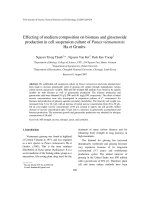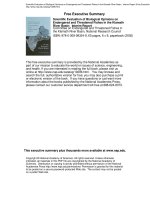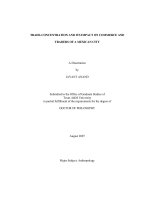Seasonal impact on ovulatory and fertility responses following presynch-heatsynch and heatsynch treatments in buffaloes
Bạn đang xem bản rút gọn của tài liệu. Xem và tải ngay bản đầy đủ của tài liệu tại đây (285.81 KB, 6 trang )
Int.J.Curr.Microbiol.App.Sci (2020) 9(5): 340-345
International Journal of Current Microbiology and Applied Sciences
ISSN: 2319-7706 Volume 9 Number 5 (2020)
Journal homepage:
Original Research Article
/>
Seasonal Impact on Ovulatory and Fertility Responses Following
Presynch-Heatsynch and Heatsynch Treatments in Buffaloes
Harmeet Singh Sandhu*, S. S. Dhindsa, M. Honparkhe and Prahlad Singh
Department of Veterinary Gynaecology and Obstetrics, Guru Angad Dev Veterinary and
Animal Sciences University, Ludhiana, India-141004
*Corresponding author
ABSTRACT
Keywords
Buffalo, Estrus
synchronization,
Season, Heatsynch,
PresynchHeatsynch
Article Info
Accepted:
05 April 2020
Available Online:
10 May 2020
The reproductive ability of buffalo is reduced during summer season. The present study
was conducted on 60 postpartum cyclic buffaloes (>45 days in milk) to assess the ovarian
activity and fertility rate following modified Heatsynch protocol. The study was conducted
during summer (May-July, n=30) and winter (December-February, n=30) seasons. In
group I, a PGF2α (Cloprostenol, 500 mcg) was administered on day -14, -2 and 7. A
gonadotropin releasing hormone (GnRH: Buserlin acetate, 10 mcg) was administered on
day 0 and estradiol (Estradiol benzoate, 1 mg) on day 8 followed by timed artificial
insemination (TAI) 48 h later on day 10. In group II, first 2 PGF2α injections were not
administered; however, rest of the treatment was similar to group I. The ovulatory
response following estradiol benzoate administration was comparable in both groups
during summer (86.66 vs. 80.00 % in group I and II, respectively) and winter (100.00 vs.
100.00 % in group I and II, respectively) seasons. However, conception rate was on higher
side in group I (60.00 %) compared to group II (26.66 %) buffaloes in summer season. In
winter season conception rate was 73.33 and 53.33 percent in group I and II, respectively.
The present findings indicated that Presynch-Heatsynch treatment may increase the
conception rate in buffaloes during summer season as compared to Heatsynch treatment.
1986). Subsequently, there is a reduction in
the number of inseminations and an increase
in the proportion of inseminations that do not
result in pregnancy (Hansen, 1997).
Introduction
The factors affecting postpartum pregnancy
rate in buffaloes are cyclicity, heat stress,
energy balance, parity, milk production, diet,
and diseases (Moreira et al., 2001; Santos et
al., 2004). The expression of decreased estrus
behaviour is mainly associated with heat
stress in bovine resulting in higher percentage
of undetected estrus (Thatcher and Collier,
The heat stress causes decrease in steroid
hormone production which alters the
follicular development and oocyte growth
(Wolfenson et al., 1997). The dominant
follicle growth is also reduced by heat stress
340
Int.J.Curr.Microbiol.App.Sci (2020) 9(5): 340-345
resulting in incomplete dominance that
increases the growth of subordinate follicles
(Wolfenson et al., 1995). Thus, the duration
of dominant follicle is increased in summer
which is negatively correlated with fertility
(Mihm et al., 1994). The heat stress results in
altered circulation and nutritive supply to the
uterus and ovaries causing impairment in
normal physiology.
considered comparatively better than the
others due to higher tendency of estrogens in
inducing estrus behaviour in buffaloes
(Sandhu et al., 2017). As buffalo reproduction
can be greatly influenced by altered ambient
temperature, the current study was conducted
to evaluate seasonal impact on ovulatory and
fertility responses following PresynchHeatsynch and Heatsynch protocols in
buffaloes.
To maintain a calving interval of 13 – 14
months, successful breeding must take place
within 85 – 115 days after parturition in
buffaloes, unfortunately that seldom occurs in
Indian conditions. Buffaloes are sexually
activated by decreased day length and
temperature. In winter the breeding frequency
of buffaloes is highest and in the summer
season it is lowest (Zicarelli, 2010). In
general, buffaloes show estrus signs during
early hours and late hours of the day with a
peak of about 37 % in early morning. The
incidence of anestrus varies between 20-80 %
in buffaloes depending on season. Maximum
percentage of buffaloes exhibit postpartum
estrus during the month of September
followed by October and minimum during
April and May due to high maximum air
temperature (Abayawansa et al., 2011). The
conception rate is also affected due to
environmental temperature variations. The
threshold thermal heat index (THI) for
conception rate has been identified as 75 and
above that threshold; the decline in overall
conception rate occurs (Dash, 2013).
Materials and Methods
The study was carried out on 60 post-partum
cyclic buffaloes (> 45 days post calving)
maintained at dairy farm, Directorate of
Livestock Farms, Guru Angad Dev
Veterinary and Animal Sciences University,
Ludhiana, Punjab, India. The selected
buffaloes had BCS 2.5 to 4 on a scale of 1 to
5 basis (Edmondson et al., 1989). The
animals were in 2nd to 6th lactations and had
a body weight ranging from 400-650 kg. All
the animals were kept under loose housing
system. Only buffaloes that were in general
good health and free from genital
abnormalities were included. The cyclic status
of all buffaloes was assessed by transrectal
ultrasonographical examination of ovarian
structures at the start of the study and only
those buffaloes that had a CL on either of the
two ovaries were included in the study.
Experimental Design
The 30 no. of buffaloes were taken in summer
season (May-July) and another 30 buffaloes
in winter season (December-February). A
modified Heatsynch protocol was applied to
animals in group I and other buffaloes were
subjected to Heatsynch protocol (Group II).
The study was conducted in 4 replicates. The
first two replicates were performed in summer
(May-July) and another two in winter
(December- February). In replicate 1st (n=15,
group I=08; group II=07), replicate 2nd
Estrus synchronization is considered a great
tool to induce estrus and ovulation in
buffaloes. Timed artificial insemination (TAI)
protocol is an effective planned breeding
program, developed in lactating dairy
animals, that allows AI without estrus
detection (Pursley et al., 1995; Pursley et al.,
1997). Many protocols have been developed
and tested in buffaloes with variable success.
The protocols involving estradiol are
341
Int.J.Curr.Microbiol.App.Sci (2020) 9(5): 340-345
(n=15, group I=07; group II=08), replicate 3rd
(n=15, group I=08; group II=07), replicate 4th
(n=15, group I=07; group II=08).
follicles and preventing emergence of a new
follicular wave (Armstrong and Webb, 1997).
In current study irrespective of the season, the
mean diameter of dominant follicle (DF) on
day -2 and 0 remained significantly larger
(P<0.05) in group I compared to II (7.44±0.14
and 9.09±0.31 vs. 6.47±0.26 and 8.02±0.30
mm, respectively). The observations indicated
favourable effect of presynchronization in
group I animals. Administration of PGF2α
before first GnRH injection of any GnRH
based treatment enhances pituitary release of
luteinizing hormone (LH) in response to
GnRH (Mirmahmoudi et al., 2014).
In group-I, on day -14 and -2, each buffalo
was
administered
PGF2α
analogue
(Cloprostenol, 500 mcg, IM). On day 0,
Gonadotropin releasing hormone analogue
(GnRH: Buserelin acetate, 10mcg, IM) was
administered. On day 7, all buffaloes were
administered PGF2α analogue (Cloprostenol,
500 mcg, IM). On day 8, estradiol benzoate
analogue (estradiol benzoate, 1 mg, IM) was
administered followed by FTAI 48 h later on
day 10. In group-II, first two injections (on
day -14 and -2) were not given and rest of the
treatment was same as explained in group I.
All buffaloes of both groups were subjected to
blood
sampling
and
transrectal
ultrasonographic examination of ovarian
structures on the days mentioned in Fig. 1.
Further, DF diameter remained significantly
higher on the day of estradiol benzoate (EB)
injection (P<0.05) and FTAI (P<0.01) in
group I (12.82±0.18 and 15.04±0.35 mm,
respectively) compared to group II
(11.19±0.42
and
12.81±0.31mm,
respectively). It has been established that if
animals ovulate after first GnRH injection,
they are more likely to have functional DF
capable of ovulation after final GnRH
injection
of
GnRH
based
protocol
(Vasconcelos et al., 1999). Within each
group, size of DF during second follicular
wave that emerged after induction of
ovulation by GnRH injection on day 0,
increased significantly (P< 0.05) after
administration of PG on day 7 by the time of
AI in both groups (Group I: 10.21 ± 0.25 to
15.04 ± 0.35; Group II: 10.01 ± 0.29 to 12.81
± 0.31 mm, respectively).
Results and Discussion
The ovulatory responses and first AI
conception rates following PresynchHeatsynch and Heatsynch treatments in
buffaloes have been presented in Table 1. Our
hypothesis was that presynchronization before
Heatsynch might improve conception rate
during low breeding (summer) season. Thus,
seasonal variability in terms of ovulatory and
conception rates in buffaloes subjected to
Presynch-Heatsynch
and
Heatsynch
treatments was analysed in the present study.
Further, follicle size was also measured by
ultrasonography to assess dominance and
ovulation. Follicular wave in buffaloes is
characterized by the presence of small
follicles (≥3mm) that use to emerge together
and develop upto 5-7 mm in diameter. Small
follicles of ̴ 4 mm diameter enter a common
growth phase during each follicular wave and
one follicle of the group grows rapidly to
attain ovulatory size (Ginther et al., 2003) by
suppressing the growth of other subordinate
The
estradiol
concentrations
were
significantly increased (P<0.05) on the day of
TAI (46.06±1.53 and 39.91±1.95 pg/ml in
Presynch-heatsynch and heatsynch groups,
respectively). The present findings were in
corroboration with the earlier report by Batra
and Pandey (1982) who reported that estradiol
concentration increases to 45-50 pg/ml at the
time of estrus. Buffalo is often considered as
seasonal breeder with reduced estrus intensity
342
Int.J.Curr.Microbiol.App.Sci (2020) 9(5): 340-345
and pregnancy rates during hot summer
months (Mohan et al., 2009). Silent estrus is
perhaps the most important factor leading to
poor reproductive efficiency in buffaloes
(Prakash et al., 2002). Moreover, estradiol
production by granulosa cells remains high in
winter and autumn compared to summer
(Wolfenson et al., 1997).
The exposure of the DF to high progesterone
(P4) environment in Presynch-Heatsynch
group might have improved the quality of
oocyte and subsequent pregnancy rate
following TAI in buffaloes.
This finding was supported by the observation
of larger (P<0.01) pre-ovulatory DF size in
buffaloes subjected to Presynch-Heatsynch
compared to Heatsynch treatment (15.04±0.35
v/s 12.81±0.31, respectively). It is believed
that higher P4 during growth of ovulatory
follicles leads to more than 10 percent
improvement in pregnancy rate following TAI
(Bisinotto et al., 2010). The possible
mechanism by which low concentration of P4
reduces fertilization and/or reduce embryo
survival rates include effects on oocyte
quality or alteration in oviductal and uterine
environment (Inskeep, 2004).
The ovulatory response following EB was
comparable in both groups during summer
(86.66 vs. 80.00 % in group I and II,
respectively) and winter (100.00 vs. 100.00 %
in group I and II, respectively) seasons. The
most important finding of current study was
observation of higher conception rate in group
I (60.00 %) compared to group II (26.66 %)
buffaloes during summer season. In winter
season, conception rate was 73.33 and 53.33
percent in group I and II, respectively.
Table.1 Influence of season on ovulatory and fertility responses following PresynchHeatsynch and Heatsynch treatments in buffaloes
Treatment
Percent of ovulatory response
(Number of buffaloes/Total
number of buffaloes)
Summer (May-July)
86.66 (13/15)
Presynch-Heatsynch (n=15)
80.00 (12/15)
Heatsynch (n=15)
Winter (December-February)
100.00 (15/15)
Presynch-Heatsynch (n=15)
100.00 (15/15)
Heatsynch (n=15)
Figures in parenthesis indicate number of animals
GROUP I (n=30)
343
Conception
rate (%)
60.00 (9/15)
26.66 (4/15)
73.33 (11/15)
53.33 (8/15)
Int.J.Curr.Microbiol.App.Sci (2020) 9(5): 340-345
GROUP II (n=30)
Fig.1 Estradiol based estrus synchronization protocols for fixed timed artificial
insemination in buffaloes
PG- Prostaglandin F2; GnRH- Gonadotrophin Releasing Hormone; EB-Estradiol Benzoate;
BS-Blood Sample; US- Ultrasound Examination; AI- Artificial Insemination
Reproduction 2: 139-46.
Batra, S.K., and Pandey, R.S. 1982/83.
Luteinizing hormone and oestradiol-17β in
blood plasma and milk during oestrous cycle
and early pregnancy in Murrah buffaloes.
Anim. Reprod. Sci. 5: 247-57.
Bisinotto, R.S., Chebel, R.C., and Santos, J.E.,
2010. Follicular wave of the ovulatory
follicle and not cyclic status influences
fertility of dairy cows. J. Dairy Sci. 93(8):
3578-87.
Dash, S. Genetic evaluation of fertility traits in
relation to heat stress in Murrah buffaloes.
2013. M.V. Sc. Thesis, ICAR-NDRI
(Deemed University), Karnal, Haryana, India.
Edmondson, A.J., Lean, I.J., Weaver, L.D.,
Farver, T., and Webster, G. 1989. A body
condition scoring chart for Holstein dairy
cows. J. Dairy Sci. 72: 68-78.
Ginther, O.J., Beg, M.A., Donadeu, F.X., and
Bergfelt, D.R. 2003. Mechanism of follicle
deviation in monovular farm species. Anim.
Reprod. Sci. 78: 239-57.
Hansen, P.J. 1997. Effects of Environment on
Bovine Reproduction. In: Current Therapy in
Large Animal Theriogenology (Eds.) R.S.,
Youngquist, W.B., Saunders and P.A.,
Philadelphia. Pp 403-415.
Inskeep, E.K. 2004. Preovulatory, postovulatory
and postmaternal recognition effects of
concentrations of progesterone on embryonic
survival in the cow. J. Anim. Sci. 82 (Supple
The reproductive efficiency of buffalo is
impaired by poor estrus expression and low
conceptions during summer season due to
intense heat stress leading to prolonged
calving intervals. The TAI protocols
involving estradiol are preferred in summer
months due to promising effect of estradiol on
estrus expression and LH surge that helps
improve buffalo fertility.
The present study findings indicated that
ovulatory and pregnancy rates could be
improved
by
incorporation
of
presynchronization prior to administration of
Heatsynch protocol during summer season in
buffaloes. Thus, Presynch-Heatsynch protocol
may successfully be used to improve
conception rate in buffaloes during summer
season.
References
Abayawansa, W.D., Prabhakar, S., Singh A.K.,
Brar, P.S. 2011. Effect of climatic changes on
reproductive
performance
of Murrah
buffaloes in Punjab: A retrospective analysis.
Indian J Anim Sci. 81(4): 334-339.
Armstrong, D. G., and Webb, R. 1997. Ovarian
follicular dominance: the role of intraovarian
growth factors and noval proteins. Review of
344
Int.J.Curr.Microbiol.App.Sci (2020) 9(5): 340-345
13): E24-E39.
Mihm, M., Baguisi, A., Boland, M.O., and Roche,
J.F. 1994. Association Between the Duration
of Dominance of the Ovulatory Follicle and
Pregnancy Rate in Beef Heifers. J. Reprod.
Fertil. 102: 123-130.
Mirmahmoudi, R., and Prakash, B. S. 2014.
Temporal changes in endogenous estrogens
and expression of behaviors associated with
estrus during the periovulatory period in
doublesynch treated Murrah buffaloes
(Bubalus bubalis). Iran. J. Appl. Anim. Sci.
4(3): 499-504.
Mohan, K., Sarkar, M., and Prakash, B.S. 2009.
Efficiency of Heatsynch protocol in estrus
synchronization, ovulation and conception of
dairy buffaloes (Bubalus bubalis). AsianAustralas J Anim Sci 22(6): 774-80.
Moreira, F., Orlandi, C., Risco, C.A., Mattos, R.,
Lopes, F. and Thatcher, W.W. 2001. Effects
of
Presynchronization
and
Bovine
Somatotropin on Pregnancy Rates to a Time
Artificial Insemination Protocol in Lactating
Dairy Cows. J. Dairy. Sci. 84: 1646-1659.
Prakash, B.S, Paul, V., and Anandlaxmi, N., 2002.
Development and validation of a simple,
sensitive, second antibody format enyzme
immunoassay for LH determination in
plasma. J. Immunol. Methods 270: 281-90.
Pursley, J. R., Mee, M. O., and Wiltbank, M. C.
1995. Synchronization of Ovulation in Dairy
Cows
Using
PGF2α
and
GnRH.
Theriogenology 44: 915-923.
Pursley, J.R., Wiltbank, M.C., Stevenson, J.S.,
Ottobre, J.S., Garverick, H.A. and Anderson,
L.L. 1997. Pregnancy Rates per Artificial
Insemination for Cows and Heifers
Inseminated at a Synchronized Ovulation or
Synchronized Estrus. J. Dairy Sci. 80:295300.
Sandhu H.S., Dhindsa S.S., Honparkhe M., Singh
Bilawal, Singhal S., and Jindal R. 2017
Relationship between Estrus Signs and
Subsequent Fertility Rates in Buffaloes
Subjected to Estradiol based Synchronization
Treatments. Theriogenology Insight: 7(3): 15.
Santos, J.E.P., Juchem, S.O., Cerri, R.L.A.,
Galvão, K.N., Chebel, R.C., Thatcher, W.W.,
Dei, C.S. and Bilby, C.R. 2004. Effect of
Bovine Somatotropin and Reproductive
Management
on
Reproductive
and
Lactational Performance of Holstein Dairy
Cows. J. Dairy Sci. 87: 868-881.
Thatcher, W.W., and Collier, R.J. 1986. Effects of
Climate on Bovine Reproduction. In: Current
Therapy in Theriogenology 2 (Eds.) D.A.
Morrow, W.B. Saunders, P.A. Philadelphia.
Pp. 301-309.
Vasconcelos, J.L.M., Silcox, R.W., Rosa G.J.M.,
Pursley, J.R., and Wiltbank, M.C. 1999.
Synchronization rate, size of the ovulatory
follicle,
and
pregnancy
rate
after
synchronization of ovulation beginning on
different days of the estrous cycle in lactating
dairy cows. Theriogenology 52(6): 1067-78.
Wolfenson, D., Lew, B.J., Thatcher, W.W.,
Graber, Y., and MedanLew, R. 1997.
Seasonal and Acute Heat Stress Effects on
Steroid Production by Dominant Follicles in
Cows. Anim. Reprod. Sci., 47: 9-19.
Wolfenson, D., Thatcher, W.W., Badinga, L.,
Savio, J. D., MedanLew, R. B. J., Braw-Tal,
R. and Berman, A. 1995. Effect of Heat
Stress on Follicular Development During the
Estrous Cycle in Lactating Dairy Cattle. Biol.
Reprod. 52: 1106-1113.
Zicarelli, L. 2010. Enhancing reproductive
performance in domestic dairy water buffalo
(Bubalus bubalis). Soc. Reprod. Fertil. Suppl.
67:443-455.
How to cite this article:
Harmeet Singh Sandhu, S. S. Dhindsa, M. Honparkhe and Prahlad Singh. 2020. Seasonal
Impact on Ovulatory and Fertility Responses Following Presynch-Heatsynch and Heatsynch
Treatments in Buffaloes. Int.J.Curr.Microbiol.App.Sci. 9(05): 340-345.
doi: />
345









